Whether you’re listening to music or surfing the waters on Malibu beach, waves (believe it or not) are around this 24/7! If you want an example of this, simply go outside – assuming it’s not cloudy – and soak up some vitamin D from the radiating waves of the sun!
Luckily when studying these topics on the MCAT, there’s a lot of overlap between the content covered here and other physics topics which can hopefully make reviewing a lot easier and more fluid for you guys!
We’ll cover the basics of waves and sounds as tested on the MCAT so that you can have a superficial understanding before getting into our more specialized study articles. Let’s go!
Waves and Sound on the MCAT: What You Need to Know
Topics on waves and sound will be tested on the Chem/Phys section of the MCAT and can appear both as passage based and fundamental discrete questions.
Again, while it’s hard to narrow down the exact number of questions about waves and sounds that might appear on the MCAT, try to expect around 3-5 questions.
Introductory physics accounts for 25% of the content covered in the Chemical and Physical Foundations of Biological Systems.
Important Sub-Topics: Waves and Sound
As mentioned above, there are a lot of physics (and even gen chem) topics that incorporate some of the basic principles outlined here! Most namely, you might see some overlap in topics like atomic emission and absorption, light and optics, etc.!
Hopefully, by first getting down the basics or even a superficial understanding of waves and sounds, you’ll also benefit in applying these basics to other physics topics!
Characteristics of Waves
Waves can be best described as a disturbance of a medium at an equilibrium! This is better understood when put into a context of an example. Suppose you have a slinky with one end attached to a wall and one free end.
You then grab one free end and move it up and down vertically, which creates a wave! In this case, the string is the medium, and your vertical up and down movement is the disturbance that causes a change in the equilibrium. Waves can be classified into 2 categories: transversal and longitudinal waves.
Transverse waves move perpendicular to the direction of the disturbance. As in the example above, when we move our hands up and down, the waves move left to right! Longitudinal waves, conversely, move parallel to the direction of the disturbance. This can be viewed when you tap on one end of a slinky that is flat on the table: we push the slinky left to right and the wave travels from left to right.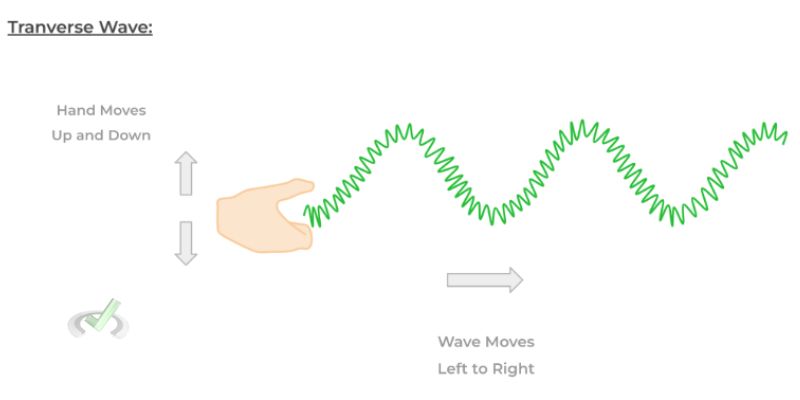
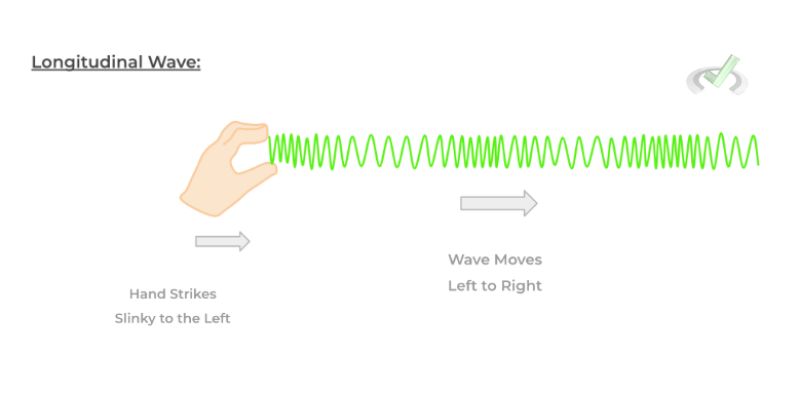
There are 4 main terms we can use to describe waves: crest, trough, wavelength, and amplitude. The crest and trough are used for the highest and lowest part of the wave, respectively. In other words, the crest is the maximum displacement in the (+) y direction while the trough is the maximum displacement in the (-) y direction.
The wavelength (𝝀) describes the distance between one crest (or trough) and another crest (or trough). Finally, the amplitude describes the value of the displacement between a crest (or trough) from the equilibrium position. Look at the visual below!

Be careful though! The amplitude is not the displacement of both the crest and trough added together: it is with respect to the equilibrium position! Finally, two additional terms that are useful to describe waves are period and frequency.
A period describes the amount of time (usually in seconds) it takes to complete one cycle which is shown below. Conversely, the frequency is the reciprocal of the period and describes how many cycles are completed in a certain amount of time.

Full Study Notes : Characteristics of Waves on the MCAT
For more in-depth content review on the general characteristics of waves, check out these detailed lesson notes created by top MCAT scorers.
Sound Production and Intensity
Whether you’re listening to a mindfulness podcast on Spotify or hearing the chants of an NBA stadium during the Game 7 Finals, you’re hearing those sounds as a result of mechanical vibrations which produce a longitudinal wave! Contrast this to light waves which are electromagnetic, transverse waves!
Because sound requires mechanical vibrations to cause particle disturbance, sound cannot travel in a vacuum and can only travel through solid, liquid, and gas mediums. Though it may seem counterintuitive, sound actually travels the fastest in solids and the slowest in gas mediums
This is due to the arrangement of particles: solids have their particles arranged close to one another which allows the propagation of the sound wave to be faster. The equation for the speed of sound is given below!

The bulk modulus simply refers to how resistant a medium is to compression; however, the more important thing to note is that it’s directly proportional to the speed. Additionally note, how the bulk modulus value decreases from solid to liquid!
Usually, when we describe how loud a sound is, we use the term volume. However, because volume is a perception and is different from person to person, scientists use another value called intensity which is more objective!
Intensity is calculated as the average rate of energy transfer (i.e. power) of sound on the surface area of an object. Remember that sound can transfer energy due to the vibration of the particles!
Because there is only a certain range of intensities humans can hear, we use a scale called the sound level (𝜷), measured in decibels, which basically is a ratio of an intensity of interest and a baseline intensity. The baseline intensity is simply the threshold of hearing for an average human ear!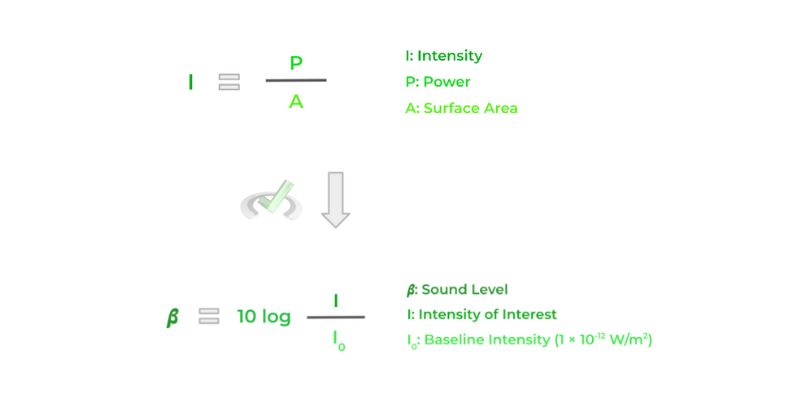
Full Study Notes : Sound Production and Intensity on the MCAT
For more in-depth content review on sound production and propagation, check out these detailed lesson notes created by top MCAT scorers.
The Doppler Effect
We’ve all experienced the Doppler Effect when an ambulance passes by you with a wailing siren: as it approaches you the pitch is very high and as it drives away, the pitch becomes lower. The Doppler Effect describes how our perception of pitch changes due to the movement of both the sound source and the detector relative to one another.
An important thing to note about the Doppler Effect is the difference between the actual frequency and perceived frequency. The sound source will always produce sound at a certain frequency, say 9 Hz.
However, based on the movement of the sound source, the sound waves reaching us can actually be compressed or become spread out which changes how we perceive the frequency.
If the waves are compressed, the frequency increases because the wavelength decreases. Conversely, if the waves are spread out, the frequency decreases because the wavelength increases!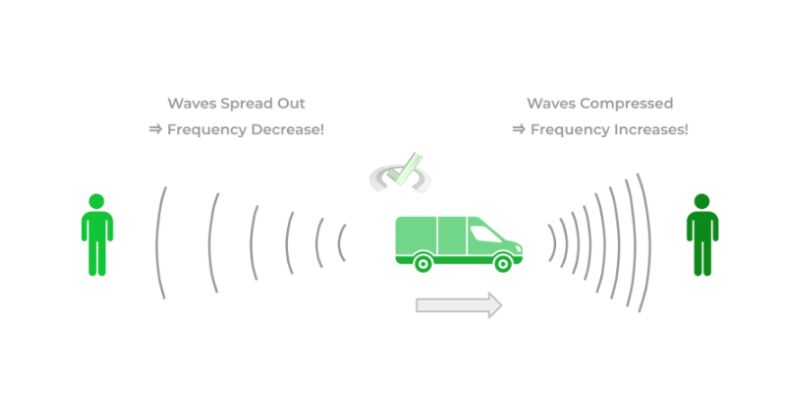
The biggest point of confusion when it comes to the Doppler effect is in the calculation and knowing which sign (+ or –) to use in a given situation! However, we’ll give you a mnemonic to help you all remember this! Below is the Doppler effect equation which can be used to calculate the perceived frequency:
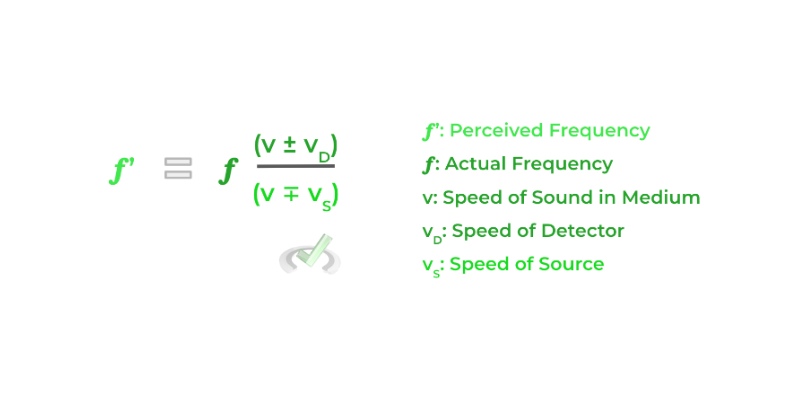
To know which sign to use, you have to know the direction of both the detector and the sound source. Here’s where our mnemonic will come in handy:
If the detector/sound source is moving TOWARD the other body, you’ll use the TOP sign
If the detector/sound source is moving AWAY from the other body, you’ll use the BOTTOM sign
For example, say the ambulance with the siren (sound source) is coming towards you and you (detector) are jogging away from it on the sidewalk. Because the ambulance is going towards you, the top sign will be used. Likewise, because you’re jogging away from the ambulance, the bottom sign will be used.

Finally, note that the plus/minus signs on the top and bottom are not the same – be careful with this when setting up your equation! Notice how the numerator has a plus/minus sign whereas the denominator has a minus/plus sign!
Full Study Notes : The Doppler Effect on the MCAT
For more in-depth content review when approaching the Doppler effect, check out these detailed lesson notes created by top MCAT scorers.
Other Wave Phenomena
In addition to the topics covered above, there are other miscellaneous topics that are important to touch upon, one of which is resonance frequencies/harmonics and standing waves! We’ll go way more in depth with this topic in our specialized overview, but for now, we can give a brief introduction.
When you propagate waves in a medium with no fixed ends, the waves can create any type of wavelength. However, if waves are propagated in a medium with fixed ends, they can interfere with each other when one wave reflects back and creates what looks like stationary waves, also called standing waves.
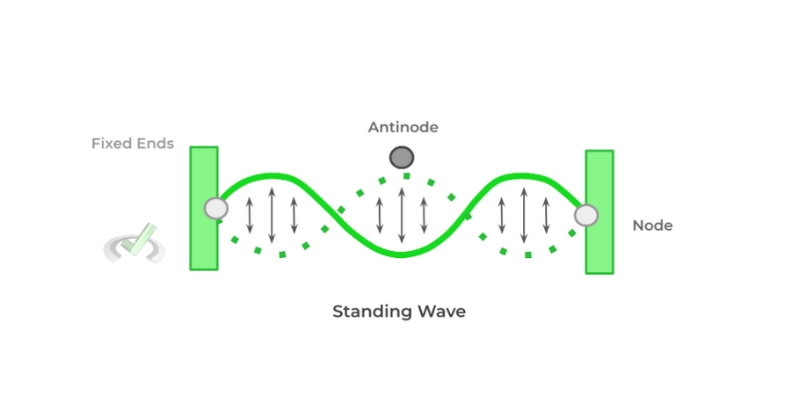
Basically, the constant crossing of the reflecting waves creates an interference pattern where it looks like the wave is just changing its amplitude and “bouncing up and down”!
Because there’s always a fixed end in the medium, there are only certain frequencies and wavelengths that can support the formation of a standing wave which are called resonant frequencies and harmonics. These specific resonant frequencies and harmonics are found via various equations and in most cases, the MCAT will test you on this topic in regards to strings and pipes as we’ll cover in our article!
Full Study Notes : Other Wave Phenomena on the MCAT
For more in-depth content review on miscellaneous wave phenomena in addition to resonant frequencies and harmonics, check out these detailed lesson notes created by top MCAT scorers.
Important Definitions and Key Terms
Below are some high yield definitions and key terms to refer to when reviewing concepts and ideas about waves and sounds!
Term | Definition |
|---|---|
Transverse Waves | Waves that travel perpendicularly to the direction of disturbance |
Longitudinal Waves | Waves that travel in parallel to the direction of disturbance |
Amplitude | Describes the magnitude of displacement from an equilibrium position to the crest (or trough) |
Crest | The highest peak of a wave |
Trough | The lowest peak of a wave |
Wavelength | The distance between 2 adjacent crests (or troughs) |
Period | Refers to how many seconds it takes for one cycle to be completed |
Frequency | Refers to how many cycle are completed in a second; Can also be thought of as the reciprocal of period |
Intensity | The ratio of a sound’s average rate of energy transfer (i.e. power) to the object’s surface area |
Doppler Effect | The phenomenon where the perceived frequency is different from the actual emitted frequency due to the movement of the sound source and the detector |
Standing Waves | Phenomenon where interactions between reflecting waves in a contained medium create the perception that a wave is not propagating |
Additional FAQs - Kinematics on the MCAT
Is Sound Tested on the MCAT?
What are Standing Waves – MCAT?
What is a Period of a Wave – MCAT?
What is the Intensity of Sound? – MCAT?
Additional Reading: Physics Topics on the MCAT:
- Circuits on the MCAT
- Electrostatics on the MCAT
- Fluids on the MCAT
- Kinematics on the MCAT
- Light and Optics on the MCAT
- Magnetism on the MCAT
- Thermodynamics on the MCAT
- Units and Dimensional Analysis on the MCAT
- Atomic and Nuclear Phenomena on the MCAT
- Work and Energy on the MCAT







 To help you achieve your goal MCAT score, we take turns hosting these
To help you achieve your goal MCAT score, we take turns hosting these 





















 reviews on TrustPilot
reviews on TrustPilot